
About Andrew Cusack
 Writer, web designer, etc.; born in New York; educated in Argentina, Scotland, and South Africa; now based in London.
Writer, web designer, etc.; born in New York; educated in Argentina, Scotland, and South Africa; now based in London. read more
News
Blogs
Reviews & Periodicals
Arts & Design
World
France
Mitteleuropa
Knickerbockers
Argentina
The Levant
Africa
Cape of Good Hope
Netherlands
Scandinavia
Québec
India
Muscovy
Germany
Academica
Greenwich Hospital
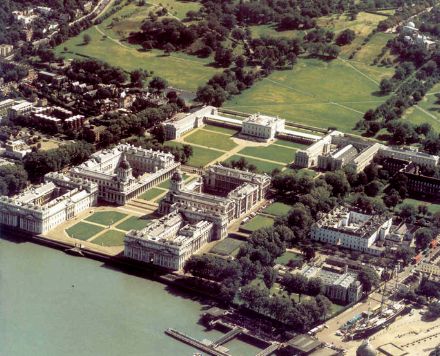
One of my favorite campuses (campii?) in the world is the Royal Hospital at Greenwhich. The site was originally home to the Palace of Placentia, a royal palace built by Humphrey, Duke of Gloucester in 1428. Placentia was the primary royal residence for two centuries up unto the Civil War, after which it fell into ruin. In 1694, the Royal Naval Hospital for Seamen was established as a home for old sailors, and grandiose architecture was required to show the monarchic splendor of a royal foundation.
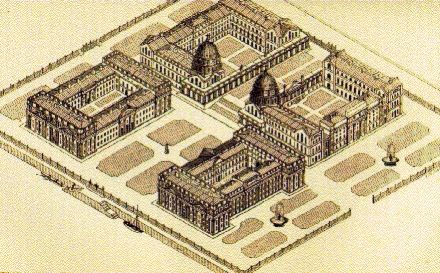
The brilliant master plan by Sir Christopher Wren incorporated the King Charles Block (the building closest to the fore in the above illustration), which had been constructed previously to a design by John Webb. The King Charles block was copied in the Queen Anne block across a large piazza (seen below), with the larger King William and Queen Mary blocks built right next to them, further from the river.
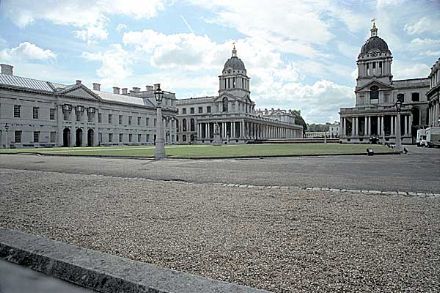
We should be grateful for the royal insistence that the view towards the River Thames from Inigo Jones’ earlier Queen’s House be preserved. Wren’s earliest plans for the Royal Hospital feature a massive central block with giant dome which prefigures its slightly later contemporary at les Invalides in Paris. Though the Queen’s House is fine in its own right, its restraint and reservedness make it undeserving of such a laudatory prospect as Wren was forced to provide it with.
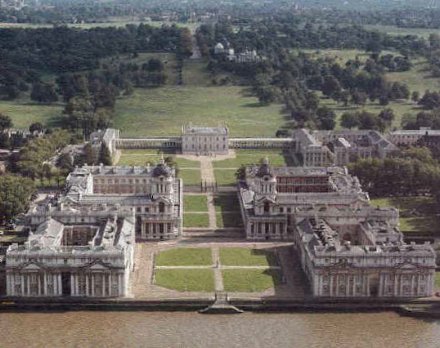
Nonetheless, the essential charm of the complex is this duplicity: instead of one, central, massive, grand dome, we get two somewhat smaller domes, an endearing couple. One was dedicated to St. Peter and the other, containing the eponymously-dedicated chapel of the shipwrecked saint, to St. Paul.
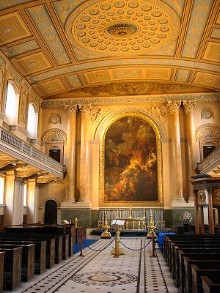
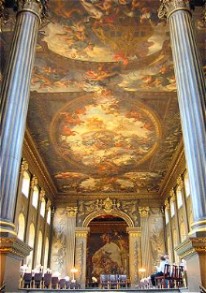
The chapel (above left), formerly featuring an apse, has been slightly reconfigured over the years, and now features a large painting of St. Paul being shipwrecked at Malta behind the altar. The dining hall (above right) is called the Painted Hall owing to its elaborate decoration. (The interior of the Painted Hall’s dome is the bottom-most photograph).
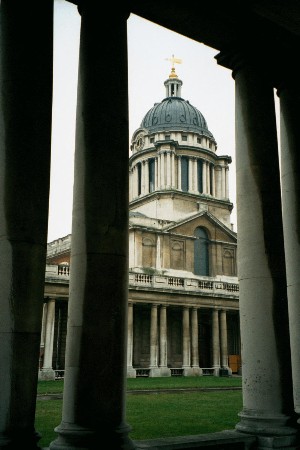
The old sailors were moved out in 1869 but from 1873 until 1998 it was home to the Royal Naval College, the staff college for Britain’s senior military service. The Royal Navy ceded that land to the Greenwich Foundation, set up specifically to look after the campus. This, in turn, has granted a 99-year lease of most of the plant to the University of Greenwich (with some space for the Trinity College of Music).
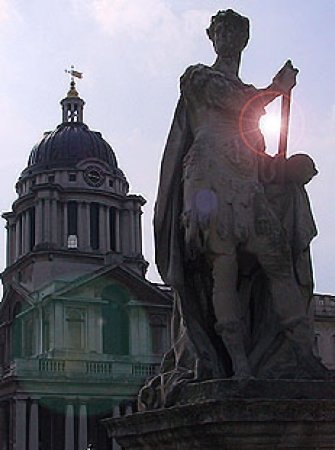
The mediocrity of this institution makes it a very poor match for such a grand home. The magnificent setting, called ‘the finest of Wren’s secular buildings’ and ‘the most distinguished group of buildings in England’ by the late art historian Margaret Whinney, ought to have been granted to the universities of Oxford or Cambridge, or perhaps as a home for some important government branch (such as the new Supreme Court which Labour plans to create to do away with the House of Lords and centuries of English legal tradtions, the multi-million pound building of which will be designed by the trendy Norman Foster; his tasteless and charm-free buildings will be out of fashion within a decade).
The anti-elitist zeitgeist in of the late 1990’s, however, proscribed even the possibility of Oxbridge or a government minsitry, and Wren’s beautiful composition was lent instead to a university which is a good few years younger than yours truly. What a pity.
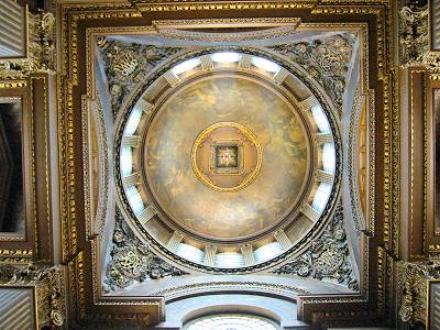
Search
Instagram: @andcusack
Click here for my Instagram photos.Most Recent Posts
- Burns Tower April 19, 2024
- Patrick in Parliament March 18, 2024
- Articles of Note: 13 March 2024 March 13, 2024
- Cambridge March 9, 2024
- Taken on Trust March 4, 2024
Most Recent Comments
Book Wishlist
Monthly Archives
Categories



Hello
I´m looking for some drawings of original anglican chapel. I´m working (hobby) at the reconstruction of the Royal Navy Hospital in Minorca (Spain)
Thanks and best regards
Alex Engel
Further to your excellent article, can I point out that for many years the buildings at greenwich also housed The Royal Hospital School. Hospital in this instance not having anything to do with medicine but used in the old sense of sanctuary. This school was set up by Royal charter in 1694 & started operations in 1712 & is the oldest military based school in the UK. The school was based in the buildings that now form The National Maritime Museum, having transferred to Holbrook, just outside Ipswich, Suffolk in 1933.
More info on the school can be found in this excellent wiki article:
http://en.wikipedia.org/wiki/Royal_Hospital_School#Greenwich_Hospital
Many thanks